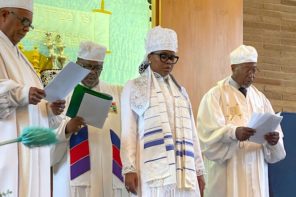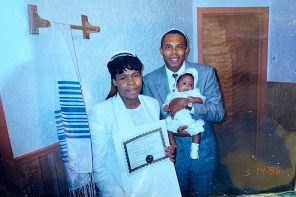In 1905, an ambitious young writer named Thomas Mann produced The Blood of the Walsungs, a novella about a family of assimilated German Jews. The story radiates contempt for these parvenus—for the patriarch, Herr Aarenhold, who collects expensive old books that he does not read; for his wife, an “ugly” woman with an ostentatious necklace “upon her shrunken breast.” The Aarenhold’s four grown children are charmless and hypercritical; Mann makes much of their “sallow” skin and “hooked” noses; as he puts it, the “facial characteristics” of their “race.”
But what’s significant about the story, aside from how much the author hates these characters, is how much these characters hate themselves. Herr Aarenhold feels “vivid self-contempt” for “the blood which flows in his veins.” His son Siegmund has “so abnormal and constant a need for purification” that he spends hours washing and dressing. Mann takes pains to telegraph how Jewish self-hatred has irredeemably warped the Aarenholds—the story ends with Siegmund deflowering his twin sister.
The Blood of the Walsungs is a nasty, fascinating piece of business. (I’d put it in the same category as T.S. Eliot’s “Burbank with a Beidecker, Bleistein with a Cigar”—masterworks of hateful snobbery.) But in its time, Mann’s theme was not so unusual. For German-speaking intellectuals in the first half of the twentieth century, the self-lacerating tendencies of assimilated Jews (real or imagined) was a serious topic of discussion, a kind of subset of the Jewish Question.
And yet, in our day, “Jewish self-hatred” is an epithet that Jews fling at other Jews—for not being religious enough, or for daring to criticize Israel. As Paul Reitter puts it in his book, On the Origins of Jewish Self-Hatred, the term is an “an instrument of censure,” a “smear.” Reitter’s title is slightly misleading—the book doesn’t explain why some Jews hate themselves. Instead he explains the origin of the term. Reitter argues that many historians have wrongly assumed that the term has always been censorious, but careful study reveals that Jewish self-hatred was first put forward for a salutary, even messianic purpose.
According to Reitter, the confusion comes about when historians don’t distinguish between Jewish self-hatred “and the similar-sounding labels that preceded it.” One such label was “Jewish anti-Semitism,” which had a variety of uses. The late nineteenth century German-Jewish press applied it to Jewish atheists and assimilationists. In 1896, Theodor Herzl wrote that Jews who questioned Zionism were “disguised anti-Semites of Jewish origin.” In 1898, Karl Kraus labeled Herzl a Jewish anti-Semite for wanting to “get the Jews out of Europe.” In 1899, Kraus wrote that “the Jewish tendencies responsible for Zionism” had driven him to consider himself a Jewish anti-Semite. (In this recriminatory atmosphere, Mann’s story seems more understandable, if not forgivable.)
Productive Self-Hatred?
This “prehistory” of Jewish self-hatred is one of the more interesting passages of Reitter’s book, and his cultural forensics about the present-day confusion seem reasonable. Still, you have to wonder: who could have possibly believed that Jewish self-hatred was a good idea? Apparently not one but two “feud-prone” German Jewish writers: Theodor Lessing (1872-1933) and Anton Kuh (1890-1941). Reitter explains that both used the concept of Jewish self-hatred as an “oppositional measure,” an attempt to “reorient the existing discourse of Jewish self-hatred” after World War I.
Kuh was a product of Vienna’s interwar café culture—a feuilletonist, a satirist, and, by many accounts, an electrifying public speaker. His ideas about the transformative power of Jewish self-hatred were first put forth in a 1919 lecture in Prague, then two years later in his book Jews and Germans. According to Kuh, assimilation was a miserable failure that actually fostered anti-Semitism. (Of course! It’s the Jews’ fault!) But assimilation was an impossible endeavor anyway, since Jews are set apart by their “Jewish essence.” Zionism, being another form of nationalism, is no answer. Instead, Jews needed to embrace productive self-hatred, a profound form of self-criticism that ultimately could transform the world.
Lessing’s preoccupations were of a reformist bent: education, feminism, socialism, and noise abatement. As for the Jews, Lessing was at first scornful, both of assimilated Westerners and Ostjuden. But then he grew interested in Judaism and Zionism. Although he was older, his conception of Jewish self-hatred clearly shows the influence of Kuh. In his 1930 book, Jewish Self-Hatred, Lessing points out that despite their self-hatred, Jews have enjoyed no small measure of success. Thus (as Reitter summarizes it) the Jews can serve as a “crucial example to the world,” a source of “healing instruction.”
All this, obviously, is vague stuff: Reitter admits that Kuh was never good at “detailed plans” and that Lessing speaks “the language of self-help.” And Reitter emphasizes that both employed “freewheeling” logic. I would add they also put a lot of responsibility on Jewish shoulders. Why should the Jews have served as a “crucial example” for anybody? They had enough problems in interwar Germany.
But Reitter’s goal, thankfully, is not to resurrect these idiosyncratic notions of Jewish self-hatred. Instead he wants to correct misconceptions about “terminological differences.” His arguments are convincing; however, while the book is short, readable, and enlightening, it is a work of scholarship—Reitter assumes that the reader is familiar with the previous work on the topic. At times I felt like I was at a dinner party where everyone was gossiping about people I had never heard of.
Reitter’s excellent book is an inadvertent reminder of how the Germans pulverized their own intellectual life. In 1933, Lessing was shot dead in Marienbad by Nazi sympathizers. Kuh fled to New York, where he dropped dead of a heart attack in 1941. Mann (who was creditably vocal in his opposition to National Socialism) was in the U.S. by 1939. The esteemed author of The Blood of the Walsungs, among other things, died at the age of 80 in a Swiss hospital.




